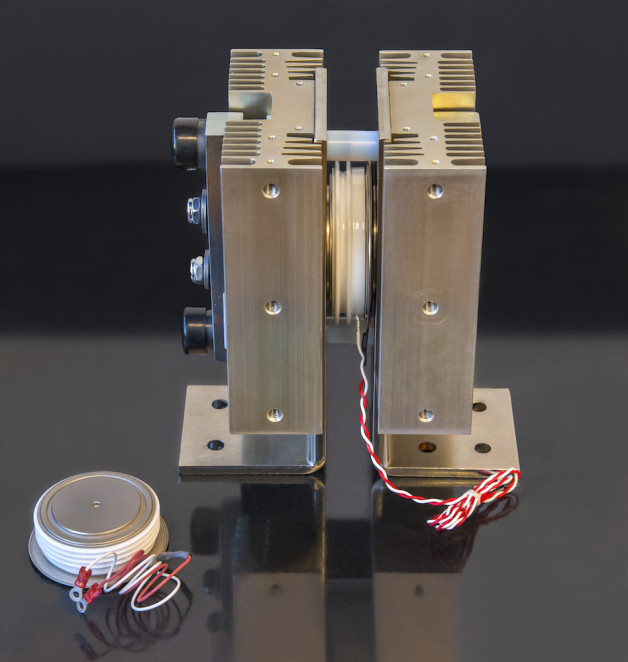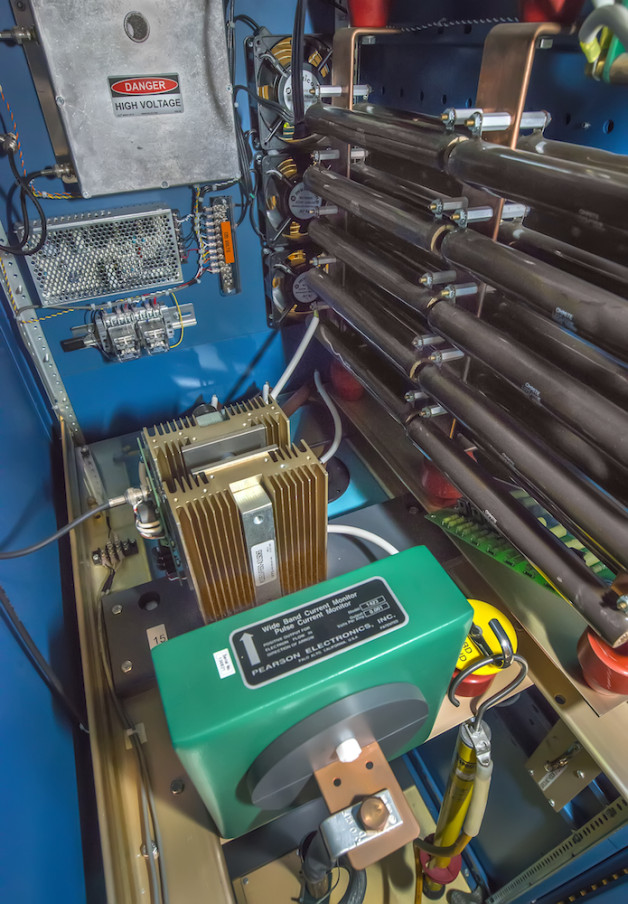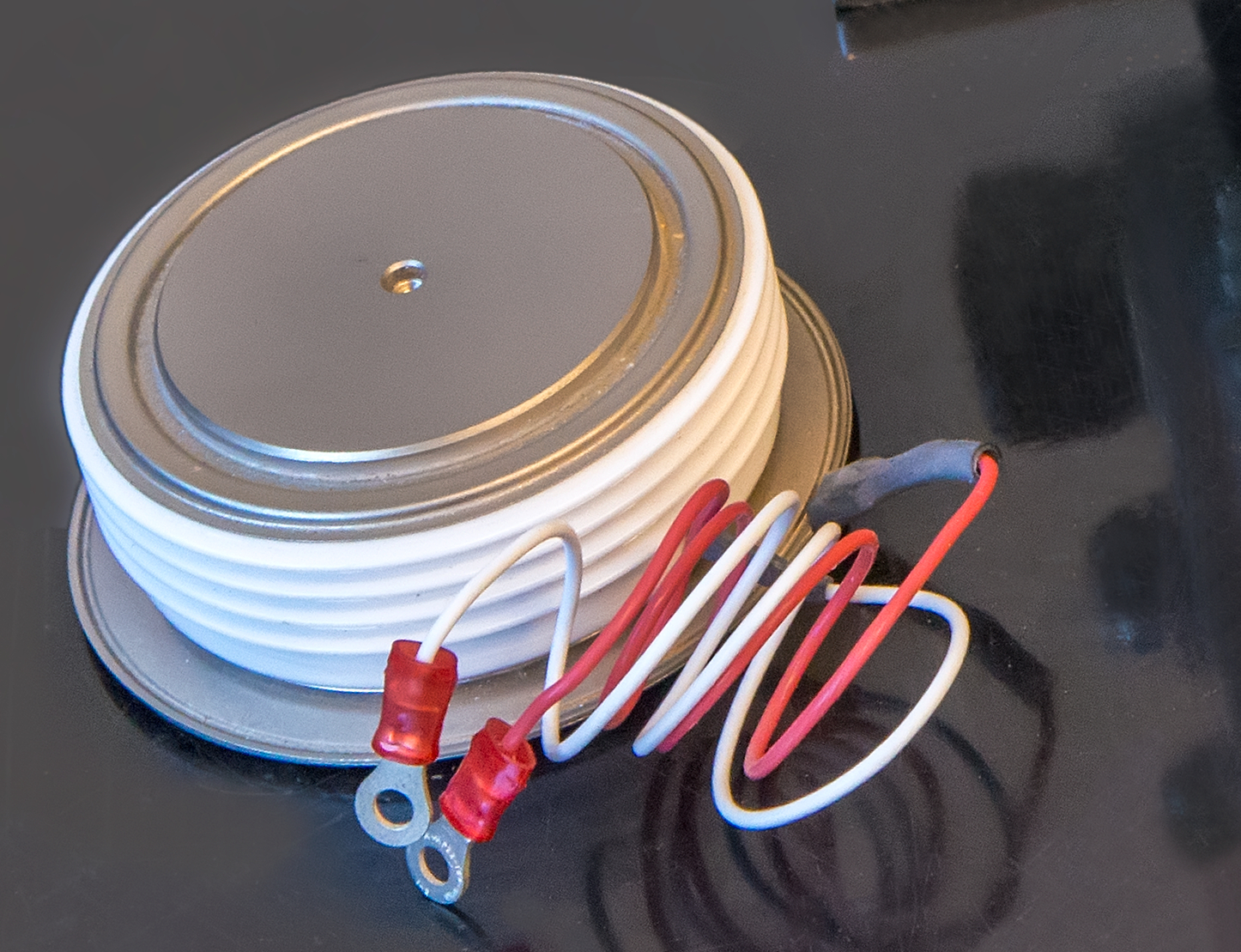
A Bay Area Regional Transit (BART) train pulls into a station. In March, dozens of BART cars were temporarily put out of service when an electrical surge caused the failure of devices called “thyristors.” Thyristors have a wide range of applications, and have been used for decades in particle accelerators at Berkeley Lab.
(Credit: Flickr/Eric Fischer via Creative Commons)
When a March 16 voltage surge disabled dozens of train cars on the San Francisco Bay Area’s busiest rail transit system, the train components that were blown out by the surge—called “thyristors”—leapt into the region’s lexicon, appearing in media coverage and social media posts.
BART (Bay Area Rapid Transit) engineers and outside experts had worked in the weeks since to resolve the electrical problems and restore normal service along one spur of the rail system, and the transit agency ordered a new batch of the palm-sized BART train thyristors, which resemble puck-shaped spark plugs with a round ceramic shell and flat metal contacts at either end.

A BART train accelerates from a station. Thyristors installed in BART cars are critical components in their propulsion systems. (Credit: Kelly Owen/Berkeley Lab)
Thyristors (pronounced THIGH-rist-ors) aren’t just for trains, though. They have been around for decades and are the workhorse for many power conversion and switching applications. They are sturdy electrical switching devices that can handle a lot of voltage and current relative to their size, with applications ranging from light dimmers to particle accelerators.
In this Q&A, Will Waldron, a high-voltage and pulsed-power engineer at the Department of Energy’s Lawrence Berkeley National Laboratory (Berkeley Lab), describes how thyristors have been used for decades in a variety of ways to keep high-power research machines running at Berkeley Lab.
Q: What are thyristors?
A: Thyristors are semiconductor or “solid-state” switches developed in the 1950s to replace vacuum and gas-filled tubes. They are ideal for power-conversion applications which often require high-power switching. A thyristor can serve as a simple electrical switch between a transformer or a charged capacitor and a load that consumes electrical power. Thyristors contain a silicon chip that allows them to turn on with an electronic trigger.
Thyristors are very economical, though custom thyristors designed for higher performance can be more costly.

Examples of thyristor types that have been used at Berkeley Lab. The palm-sized thyristor at bottom left is an example of a typical device, with red and white trigger wires. On the right, a thyristor (middle) is mounted between two metal heat sinks, which conduct heat away and help cool the device during high-power operation. (Roy Kaltschmidt/Berkeley Lab)
Q: What is the history of Berkeley Lab’s use of thyristors?
A: Pioneering work at Berkeley Lab in the late 1970s and 1980s used series and parallel combinations of thyristors for very high-voltage and high-current electrical switching and for unique power-conversion applications related to magnetic fusion energy research.
We have found many useful applications for these devices in particle accelerators such as magnet power supplies and high-voltage pulsers.
In addition to many lower-power applications, several critical high-power magnet power supplies at the Advanced Light Source, the Superconducting Magnet Test Facility, and the 88-inch Cyclotron at Berkeley Lab use thyristors for power conversion and regulation.

This photo shows a thyristor assembly (the gold-colored, layered structure at middle) that incorporates a thyristor (not visible) between two heat sinks at NDCX-II (the Neutralized Drift Compression Experiment), an ion-beam accelerator at Berkeley Lab. This thyristor switches thousands of amps to the beam-focusing magnets along the NDCX-II beamline. (Roy Kaltschmidt/Berkeley Lab)
We are now testing specialized thyristors at the BELLA (Berkeley Lab Laser Accelerator) Center to replace older switches based on gas-filled tubes known as thyratrons. This should help reduce timing jitter and increase switch lifetime to benefit future applications of laser plasma accelerators.
Q: What modern devices are now replacing thyristors?
A: Insulated gate bipolar transistors, or IGBTs, and metal oxide semiconductor field effect transistors, or MOSFETS, are much faster than thyristors, but they are more expensive and are more limited in their power ratings.
Currently available IGBTs can handle high power, and the cost is coming down. Many power conversion and pulsed power applications that require the fastest switching speeds have moved from thyristors to IGBTs and MOSFETs to improve performance.
Q: What are common causes of thyristor failure?
A: Over-voltage conditions and switching current too quickly.
Q: What other devices can be coupled to thyristors to enhance their effectiveness and/or prolong their life?
A: Various combinations of resistors, capacitors, diodes, and metal-oxide varistors are used to suppress voltage transients and protect the device from excessive voltage. Series fuses and inductors can be used to protect the device from excessive current and to limit the rise in current.
In some pulsed-power applications, we often rely on a series array of thyristors, which together can hold off a voltage much higher than the voltage rating of a single device. For these applications, protecting each device from excessive voltage is critical.
In other applications we are pushing the devices to switch current quickly and we have to make sure that the specifications of the switch are not exceeded.
Will Waldron is currently the deputy chief engineer for the LUX-Zeplin (LZ) experiment, an underground dark matter-hunting experiment that is managed by Berkeley Lab.
